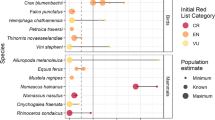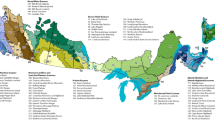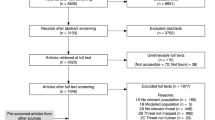Abstract
Red lists serve as the most prominent tool for priority setting in applied conservation, even though they were not originally designed for this task. Hence, threat status does not always reflect actual conservation needs and can be very different from actual conservation priorities. Therefore, red lists may at best be a suboptimal tool for setting conservation priorities in a country or region. As a response, a range of alternative or complementary tools have been developed, with approaches, methods, and parameters such as population decline, population center etc. used, differing widely among countries. One recent development is the combination of conservation status with a measure of the international importance of a population in a focal region for the global survival of a species. Here, we provide a new method that integrates the two concepts while keeping them conceptually separate. The main benefit of this method is that it can be applied across variable geographical scales such as regions, countries, and even continents. Furthermore, it allows for better recommendations for applied conservation and conservation policy development than the two concepts in isolation. Our method, if applied internationally, would allow for a standardized priority setting in species conservation, would be highly comparable between countries, and would lead to a more efficient use of the limited financial and human resources for monitoring and conservation of biodiversity.

Similar content being viewed by others
References
Baillie J, Hilton-Taylor C, Stuart SN (2004) IUCN Red List of threatened species: a global species assessment, International Union for Conservation of Nature and Natural Resources Red List, Programme, World Conservation Union Species Survival, Commission, IUCN—The World Conservation Union
Beissinger SR, Reed JM, Wunderle JM Jr et al (2000) Report of the AOU conservation committee on the Partners in Flight species prioritization plan. Auk 117(2):549–561. doi:10.1642/0004-8038(2000)117[0549:ROTACC]2.0.CO;2
Brooks T, Hannah L, Da Fonseca GAB et al (2001) Prioritizing hotspots, representing transitions 2. Trends Ecol Evol 16(12):673. doi:10.1016/S0169-5347(01)02349-7
Brooks TM, Mittermeier RA, da Fonseca GAB et al (2006) Global biodiversity conservation priorities. Science 313(5783):58–61. doi:10.1126/science.1127609
Carter MF, Hunter WC, Pashley DN et al (2000) Setting conservation priorities for landbirds in the United States: the partners in flight approach. Auk 117(2):541–548. doi:10.1642/0004-8038(2000)117[0541:SCPFLI]2.0.CO;2
Coates DJ, Atkins KA (2001) Priority setting and the conservation of Western Australia’s diverse and highly endemic flora. Biol Conserv 97(2):251–263. doi:10.1016/S0006-3207(00)00123-3
Couturier A (1999) Conservation priorities for the birds of Southern Ontario. Technical appendices, and priority species lists 15, Bird studies Canada, Port Rowan, Ontario
Eaton MA, Gregory RD, Noble DG et al (2005) Regional IUCN Red Listing: the process as applied to birds in the United Kingdom. Conserv Biol 19(5):1557–1570. doi:10.1111/j.1523-1739.2005.00213.x
Evans D (2005) Natura 2000: completing the EU’s network of sites to conserve flora and fauna. PlantTalk 39:22–27
Fitzpatrick UNA, Murray TE, Paxton RJ et al (2007) Building on IUCN regional red lists to produce lists of species of conservation priority: a model with Irish bees. Conserv Biol 21(5):1324–1332. doi:10.1111/j.1523-1739.2007.00782.x
Freitag S, Jaarsveld ASV (1997) Relative occupancy, endemism, taxonomic distinctiveness and vulnerability: prioritizing regional conservation actions. Biodivers Conserv 6(2):211–232. doi:10.1023/A:1018392019594
Gärdenfors U (2000) Population viability analysis in the classification of threatened species: problems and potentials. Ecol Bull 48:181–190
Gärdenfors U (2001) Classifying threatened species at national versus global levels. Trends Ecol Evol 16(9):511–516. doi:10.1016/S0169-5347(01)02214-5
Guralnick RP, Hill AW, Lane M (2007) Towards a collaborative, global infrastructure for biodiversity assessment. Ecol Lett 10(8):663–672. doi:10.1111/j.1461-0248.2007.01063.x
IUCN (1996) IUCN Red list of threatened animals
IUCN (2001) IUCN Red List categories and criteria: version 3.1
Keller V, Bollmann K (2004) From red lists to species of conservation concern. Conserv Biol 18(6):1636–1644. doi:10.1111/j.1523-1739.2004.00464.x
Knight AT (2006) Failing but learning: writing the wrongs after Redford and Taber. Conserv Biol 20:1312–1314
Knight AT, Cowling RM (2007) Embracing opportunism in the selection of priority conservation areas. Conserv Biol 21:1124–1126. doi:10.1111/j.1523-1739.2007.00690.x
Koomen P, van Helsdingen PJ (1996) Listing of biotopes in Europe according to their significance for invertebrates. Council of Europe Publications, Strasbourg, France
Mace GM, Balmford A, Boitani L et al (2000) It’s time to work together and stop duplicating conservation efforts. Nature 405(6785):393. doi:10.1038/35013247
Margules CR, Pressey RL (2000) Systematic conservation planning. Nature 405(6783):243–253. doi:10.1038/35012251
Mehlman DW, Rosenberg KV, Wells JV et al (2004) A comparison of North American avian conservation priority ranking systems. Biol Conserv 120(3):383–390. doi:10.1016/j.biocon.2004.03.013
Miller RM, Rodriguez JP, Aniskowicz-Fowler T et al (2007) National threatened species listing based on IUCN criteria and regional guidelines: current status and future perspectives. Conserv Biol 21(3):684–696. doi:10.1111/j.1523-1739.2007.00656.x
Moritz C (1994) Defining “evolutionary significant units” for conservation. Trends Ecol Evol 9:373–375. doi:10.1016/0169-5347(94)90057-4
National Recovery Working Group (2005) National biological ranking. System for recovery of species at risk. Environment Canada, Gatineau, Quebec, Canada. Unpublished Report
Rabinowitz A (1981) Seven forms of rarity. In: Synge H (ed) The biological aspects of rare plant conservation. Wiley, Chichester, pp 205–235
Sagarin RD, Gaines SD, Gaylord B (2006) Moving beyond assumptions to understand abundance distributions across the ranges of species. Trends Ecol Evol 21(9):524–530. doi:10.1016/j.tree.2006.06.008
Samways MJ (2003) Marginality and national red listing of species. Biodivers Conserv 12(12):2523–2525. doi:10.1023/A:1025840000200
Schmeller DS, Gruber B, Budrys E, Framsted E, Lengyel S, Henle K (2008a) National responsibilities in European species conservation: a methodological review. Conserv Biol 22:593–601. doi:10.1111/j.1523-1739.2008.00961.x
Schmeller DS, Gruber B, Bauch B, Lanno K, Budrys E, Babij V et al (2008b) Determination of national conservation responsibilities in regions with multiple political jurisdictions. Biodivers Conserv. doi:10.1007/s10531-008-9439-8
Schnittler M, Günther KF (1999) Central European vascular plants requiring priority conservation measures: an analysis from national red lists and distribution maps. Biodivers Conserv 8(7):891–925. doi:10.1023/A:1008828704456
The Nature Conservancy (1988) Natural heritage program operations manual. Arlington, Virginia, USA
Acknowledgements
This article is a result from the EU-project EuMon (http://eumon.ckff.si), founded by the EU-Commission (contract number 6463). We would like to thank other EuMon-colleagues for discussions.
Author information
Authors and Affiliations
Corresponding author
Rights and permissions
About this article
Cite this article
Schmeller, D.S., Bauch, B., Gruber, B. et al. Determination of conservation priorities in regions with multiple political jurisdictions. Biodivers Conserv 17, 3623–3630 (2008). https://doi.org/10.1007/s10531-008-9446-9
Received:
Accepted:
Published:
Issue Date:
DOI: https://doi.org/10.1007/s10531-008-9446-9




